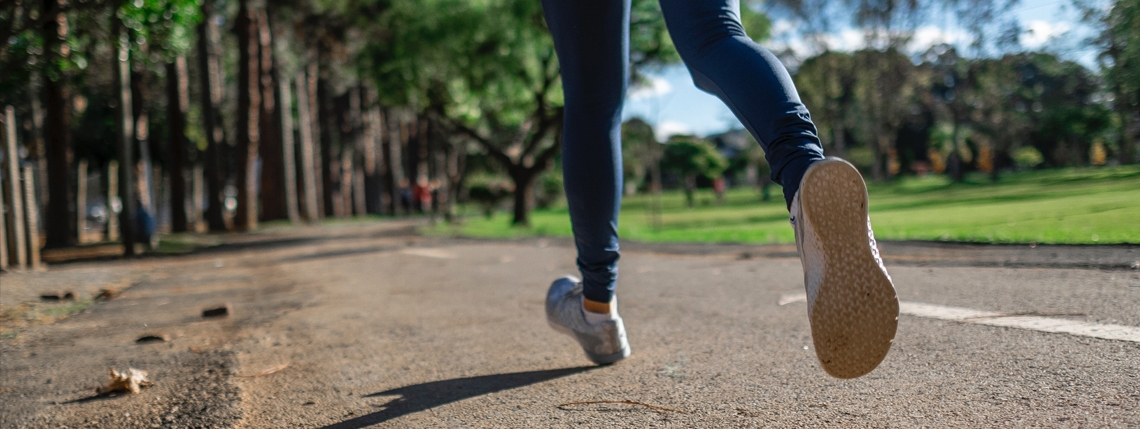COVID-19 exercise guidelines have certainly limited how we exercise. But if, before coronavirus, you usually spent all your exercise time in the gym, you might find getting outside to exercise has a positive impact. Mike Rogerson makes a case for outdoor exercise.
At the University of Essex, we’ve been examining whether it matters where people exercise and, perhaps unsurprisingly, it turns out that environments can be important.
A systematic review of research shows that, compared to indoor or ‘built’ urban outdoor environments, green spaces such as parks can boost the mood- and self-esteem-enhancing properties of exercise1. An early ground-breaking study even found that viewing images of pleasant rural scenes during treadmill exercise could have a similar impact. This study led to the term ‘green exercise’ – referring to physical activity while experiencing nature2.
The most frequently reported psychological influences of environment are mood and self-esteem. It may be that these are generated by outdoor environments offering a greater sense of satisfaction associated with mastery of the exercise task, in battling the elements or navigating a route. Dr Eric Brymer and colleagues explain that, compared to synthetic environments, natural environments provide more challenging, complex, varied and intense behavioural possibilities3,4, whereby individuals can experience a broad range of emotions and other psychological feelings, such as mindfulness, peace and calm3. Whereas some gym equipment allows for controlled, set movements, outdoor exercise can enable greater variation, which can translate into more all-round functional strength or balance gains; you can change direction running outside but not on a treadmill.
Another psychological enhancement offered by green spaces is that of ‘attention’ – the cognitive resource we use to concentrate. Exercise facilitates restoration of depleted attentional resources, and performing exercise in nature-based environments can result in more pronounced improvements5. Indeed, the research attests that a desire for contact with nature is not just the result of a romanticised view of nature, but is an important adaptive process that appears to aid optimum functioning6.
Research has also tended to find an effect of environmental settings on how hard individuals feel they are working during exercise – termed ‘perceived exertion’. During self-paced exercise, individuals walk faster and work harder (measured by heart rate), yet report lower perceived exertion during outdoor walking compared to indoor treadmill walking7. Concurrently, when exercising at an instructed perceived exertion, individuals work harder (measured by speed, heart rate and blood lactate concentration) during outdoor exercise than during indoor treadmill exercise8. This should be a consideration both as a tool for positively manipulating or deceiving training and performance experiences, and in relation to risk management with vulnerable clients9.
Regarding the physiological influences of exercise environments, exercising while being exposed to nature can have greater beneficial effects on blood pressure2,10, other measures of cardiovascular and autonomic function11-14, and endocrine and immune function10,15,16. Compared to built environments, walks in park settings can promote patterns of nervous control of the heart that indicate enhanced restorative aspects of sleep14. Outdoor exercise settings also appear to be more conducive to social interaction during exercise, encouraging individuals to talk, even when exercise has exactly the same physical characteristics as indoor equivalent exercise17.
In all, environments might be engaged to create satisfying exercise experiences. Indeed, people have reported greater enjoyment of outdoor exercise than of equivalent ‘non-green’ exercise7. Environment-triggered boosts might increase individuals’ intentions to maintain exercise behaviours, thus improving adherence levels17.
A long-standing problem for research findings is that they can struggle to make the leap to real-world practical application. Fortunately, with the assistance of a PT and his clients, anecdotal evidence has been gathered, which is suggesting that reported outcomes seem to translate to practice. Of course, all this doesn’t mean there is no benefit to doing equivalent exercise indoors, or that more controlled gym environments aren’t better for some contexts, needs and movement types. Exercise is good for us and sessions need to be tailored to clients. However, what the research does show is that some exercise benefits are better accessed and engaged through using green spaces.
About the author

Dr Mike Rogerson is a researcher at the Centre for Sports and Exercise Science, University of Essex. His academic research is in the area of Green Exercise, focusing on understanding the role of environments in exercise participation and outcomes, with a particular interest in psychological well-being.







